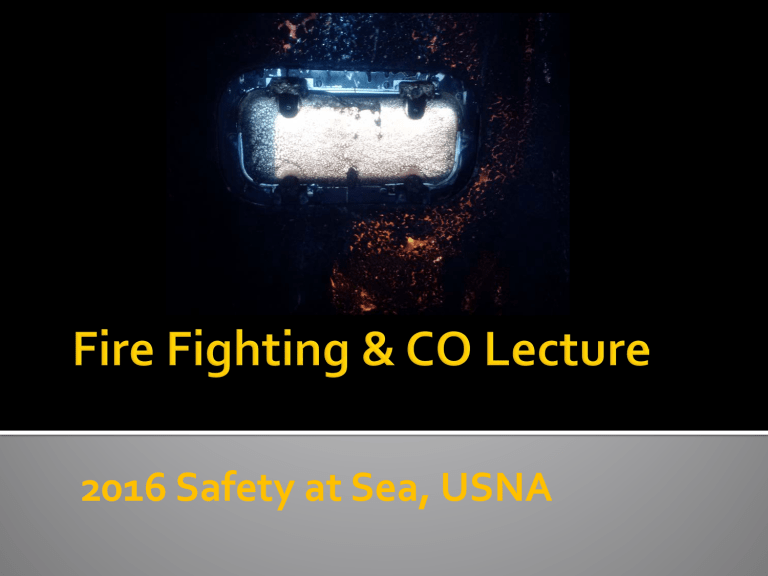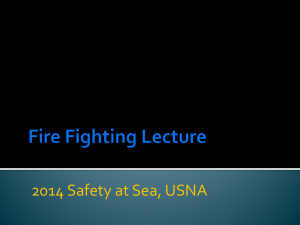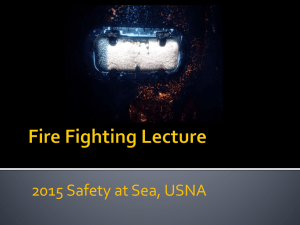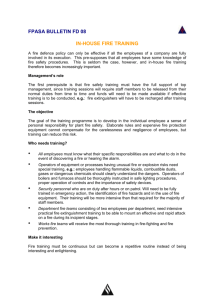Fire Fighting
advertisement

2016 Safety at Sea, USNA fdross50@aacounty.org Fuel Heat And a Chemical chain reaction Oxygen Remove one of these, and you can put out a fire! * Note items in “red” …you will need that information later! Materials which leave an Ash: Wood, cotton, fiberboard, cushions, sails Effective extinguishers: Water (Caution – load limits!) Dry Chemical Carbon Dioxide Concerns: Fire may be deeply embedded in materials and require “overhaul.” Ok, what is overhaul? This was a covered marina made of wood! See the boats? BoatU.S. Insurance BoatU.S. Insurance Flammable liquids (things that boil): Oil, gasoline, resin, paint, kerosene, diesel Effective extinguishers: Sodium Bicarbonate (baking soda, NOT flour!) Dry Chemical Carbon Dioxide (denies O2, short lived on B fires) Halon replacements Concerns: Water may spread the fire! Liquids with high flashpoint may re-ignite (keep covered to avoid vapor release) Would the fire extinguishers on your boat put this fire out? How hot is it on the bow of this boat…could you stand there? BoatU.S. Insurance Where would you go if this happened to you sailing offshore? Could you abandon your boat in two (2) minutes? BoatU.S. Insurance How would you get out of this boat if you were asleep in the v-berth? Do you think they had a smoke or CO detector? BoatU.S. Insurance Electrical Fires (shorts): Wire insulation and adjacent materials Tactics: Break circuit, turn off main switch (first step!), have circuit protection Then extinguish according to what materials are involved Water is not a choice on Class C fires Concerns: Shock hazard (is the power off – are you sure?) Shore Power Connections This is one of the most common types of electrical fires boaters experience at a marina. So, do you have a procedure to disconnect your shore power? 1) 2) 3) 4) Turn off dock’s breaker to the pedestal and then the main AC breaker in boat; Unplug shore power at pier; Disconnect the shore power from boat receptacle; Reverse the process when hooking into shore power and remember to verify polarity. The power was still on to this plug when this picture was taken! Photo by - jbacchi BoatU.S. Insurance Fires caused by burning metals: Flares are the main concern Nickel Metal Hydride batteries (example is gaming devices) Tactics: Get it off the boat May use material to try to cool, isolate and smother Concerns: Does not play nice with water! 55% Poorly installed electrical systems (C) 30% DC shorts and wiring 12% DC engine voltage regulator 4% AC appliance/heater 4% AC shore power system 2% AC wiring/panel 2% DC battery charger 24% Engine and Transmission Overheating 19% engine overheating 2% turbocharger overheat 2% transmission overheat 1% backfire 8% Gasoline fuel leak 95% of fuel-related fires involve gasoline 1% Galley stoves Declining compared to when alcohol stoves were popular (this happened to me – alcohol stove fire) 12% Unknown or miscellaneous BoatU.S. Insurance BoatU.S. Insurance BoatU.S. Insurance BoatU.S. Insurance ABC Covers ALL Classes of Fires Except “D” fires! Low toxicity Inexpensive Deploy quickly Messy clean up Inexpensive Portables Tri-Class or Multipurpose Dry Chemical (“ABC”): No worry about selecting the right extinguisher Forms a crust on Class A fires, making clean up challenging Need to turn upside down and shake it to loosen the powder on a regular basis! Needs to be recharged at least yearly (even if not used)! Old ones can be used for crew training but make a mess – nontoxic! Tri-Class Portable Carbon Dioxide Cools and suffocates Large extinguishers! Leaves no residue Halon and its derivatives Halon 1211 and 1301 cannot be bought, but can be refilled Halotron 1 is a replacement Halotron Portables FM-200 Halon replacement Mounted in the engine room Heat causes “stinger” to activate Stinger FM-200 “Fixed” System on a Navy 44’ Mark II Manual Lever/Cockpit Automatic Heat Coupler Alarm Sensor Harness Have extinguishers located in all occupied spaces of the boat, cockpit, and the engine room. Fight a fire quickly; fires are virtually impossible to put out if given a head start. Fire volume can double every 7 seconds!!!! Use extinguishers to allow you to escape from below. How could you get out of every stateroom, head or compartment if the main hatch was blocked? PASS – Pull-Aim-Squeeze-Sweep (Aim extinguisher low at base of fire and sweep across base of flames.). Turn off all blowers and close vents to space with the fire! Engine fire: blower off, engine off, power off and fuel valve off. Install extinguishers above floor - keep them away from water! Have a back-up person assist ; close at hand with the extra extinguishers! Use a flashlight and stay oriented; Stay low - avoid smoke (better visibility); Smoke kills more people in fires than actual burns. Do a dry run, with a knit cap and try to get out of your boat without using the main hatch. Have an exit plan! “Carbon monoxide is an odorless, tasteless, [and] initially non-irritating, gas created by incomplete fossil fuel combustion … in appliances like gaspowered electrical generators, propane stoves or heaters, or your boat’s propulsion engine.” The Danger to Boaters from Carbon Monoxide, Tom Burden, West Marine, West Marine Advisor. “Carbon Monoxide (CO) is lighter than propane or gasoline vapor, without smell or taste, its presence remains undetected by humans.” Id. “CO is easily absorbed into the bloodstream (combining with hemoglobin 200 times more easily than oxygen) where it reduces the blood’s oxygencarrying ability, leading to hypoxia and causing “suffocation” by the victim.” Id. “…[s]ymptoms of CO poisoning resemble those of other common conditions (e.g., alcohol consumption, motion sickness, heat stress, and nonspecific viral illness), poisonings often go unrecognized.” CDC, MMWR, December 15, 2000. Or for us, seasickness! “CO has a molar mass of 28.0, and air has an average molar mass of 28.8. The difference is so slight that CO is found to evenly distribute itself indoors.” Carbon Monoxide Facts, Healthy Building Science. “The National Fire Protection Association says CO detectors “shall be centrally located outside of each separate sleeping area in the immediate vicinity of the bedrooms.” Additionally, each CO detector “shall be located on the wall, ceiling or other location as specified in the installation instructions….” • • • • • • Operate combustion devices (stoves, heaters, generators) in well-ventilated areas; Supplement natural ventilation with fans or forced air. Keep forward-facing hatches open to allow fresh air circulation in accommodation spaces, even in inclement weather; Close the hatches and set your course away from the path of exhaust fumes when motoring downwind in a following sea; Install CO detectors in each cabin and/or space. It’s the most effective defense against a potentially fatal problem; Avoid any activity on the rear deck, swim platform, and around exhaust pipes while the engine or generator is running; CO exposure danger also exists on deck, especially when a boat idles at the dock or seawall where exhaust can accumulate. Even when not running your engine, beware of CO accumulation from other boats. Have a fire escape plan and practice it; Install CO and smoke alarms in each compartment; Remember, CO is the silent killer! Change your smoke alarm and CO alarm batteries yearly (at least); Make sure everyone knows how to call for help; Have fire extinguishers readily available and make sure everyone knows how to use them. Lineman Gloves for thunderstorms (ANSI/ASTM certified) (“may help you if you have to be at the helm”); Fire Fighter Gloves (NFPA certified) for Class D fires …moving hot/burning items (better then non-insulated gloves); Smoke Hoods (they do NOT provide air!); Fire extinguishers, fire blanket, CO and smoke alarms, etc. Questions? Ok, time to go outside and have some fun: 1) Fire Safety Trailer; 2) Electrical Short Simulator.




